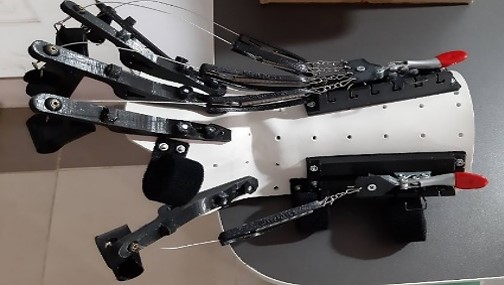The design of functional mechanical hand device for spasticity hand functions
Main Article Content
Abstract
Stroke patients usually have disability on body opposite to damaged brain side. Recovery of upper limb is more difficult than lower limb. In addition, the distal parts of limbs are less recoverable and slower than the proximal parts. Moreover, in some cases, no longer recover any hand functions. They are not weakness only, but there are also spasticity that limit hand functions training after stroke. In moderate to severe spasticity, patients cannot open hand by self. So, the functional mechanical hand device is invented for assisting open spasticity hand, allowing patients to practice their hands by themselves every day. The main components of this prototype are springs separating of individual finger. The spring force acts finger extension. Individual finger spring has a unique force like the natural force proportion of any finger. That reason for each finger moves close to the natural fine movement independently while using the device. Also, the wrist of device is in suitable position for using hand. The simulation results of this prototype show that there is strength and safety in use. Especially, it is suitable for this patient type. The biomechanical test results in the healthy subject show that range of motion (ROM) of fingers are in the desired motion range. It is suitable to each task gestures of the finger.
Article Details

This work is licensed under a Creative Commons Attribution-NonCommercial-ShareAlike 4.0 International License.
This work is licensed under a Creative Commons Attribution-NonCommercial-ShareAlike 4.0 International License.
References
Bureau of Non-Communicable Diseases, Department of Disease Control, Thailand. URL: http://thaincd.com/document/file/download/knowledge/ประเด็นสารรณรงค์วันอัมพาตโลก_ปี_2561.pdf, accessed on 03/12/2020, 2018. [In Thai].
Faculty of Medicine, Siriraj Hospital, Thailand. URL: https://www.si.mahidol.ac.th/sidoctor/e-pl/admin/article_files/1256_1.pdf, accessed on 03/12/2020, 2016. [In Thai].
Lee, K.B., Lim, S.H., Kim, K.H., Kim, K.J., Kim, Y.R., Chang, W.N., et al. Six-month functional recovery of stroke patients: a multi-time-point study, Int J Rehabil Res, Vol. 38(2), 2015, pp. 173-180.
Hatem, S.M., Saussez, G., della Faille, M., Prist, V., Zhang, X., Dispa, D., et al. Rehabilitation of motor function after stroke: a multiple systematic review focused on techniques to stimulate upper extremity recovery, Frontiers in Human Neuroscience, Vol. 10, 2016, pp. 442.
Dong-Geol, L. and Dong-Yeop, L. Effects of adjustment of transcranial direct current stimulation on motor function of the upper extremity in stroke patients, Journal of Physical Therapy Science, Vol. 27(11), 2015, pp. 3511-3513.
Kyung Min, L., Jinhwa, J., Sunhwa, S. The effect of bilateral trainings on upper extremities muscle activation on level of motor function in stroke patients, Journal of Physical Therapy Science, Vol. 28(12), 2016, pp. 3427-3431.
Jeong-Hui, K. and Moon-Young, C. Effects of modified constraint-induced movement therapy on upper extremity function and occupational performance of stroke patients, Journal of Physical Therapy Science, Vol. 30(8), 2018, pp. 1092-1094.
Sharma, P., Sutaria, J.M., Zambare, P. Effects of Neuromuscular Electrical Stimulation (NMES) on hand function in stroke patients, Indian Journal of Physiotherapy & Occupational Therapy, Vol. 9(3), 2015, pp. 43-48.
Harishchandre, M.S. and Singaravelan, R.M. Effectiveness of emg biofeedback on improving hand function in hemiplegic stroke patients, Romanian Journal of Physical Therapy / Revista Romana de Kinetoterapie, Vol. 18(30), 2012, pp. 56-63.
Hoffman, H.B. and Blakey, G.L. New design of dynamic orthoses for neurological conditions, NeuroRehabilitation, Vol. 28(1), 2011, pp. 55-61.
Andringa, A.S., Van de Port, I.G.L, Meijer, J-W.G. Tolerance and effectiveness of a new dynamic hand-wrist orthosis in chronic stroke patients, NeuroRehabilitation, Vol. 33(2), 2013, pp. 225-231.
Marx, R.H. Inventor, Dynamic splinting component; 1988.
Hoffman, H.B. and Kovacevich, I.D. Inventors, Dynamic hand splints; 2013.
Wen-Dien, C. and Ping-Tung, L. New design of home-based dynamic hand splint for hemiplegic hands: a preliminary study, Journal of Physical Therapy Science, Vol. 27(3), 2015, pp. 829-831.
Marx, R.H. Inventor, Dynamic outrigger extension for dorsal wrist splints; 1986.
Duncan, C.C. and Edgley, S.R. Upper limb orthoses for the stroke- and brain-injured patient, 5th edition, 2019 Elsevier, Amsterdam.
Miller, L.C. and Dewald, J.P.A. Involuntary paretic wrist/finger flexion forces and EMG increase with shoulder abduction load in individuals with chronic stroke, Clinical Neurophysiology, Vol. 123(6), 2012, pp. 1216-1225.
Wangtiyong, W., Boonyayothin, V., Nankongnab, N., Siri S. Developing Concept of a Knife for Trimming Welds of Plastic Pallets, paper presented in The 4th STOU Graduate Research Conference, 2014, Nonthaburi, Thailand.
Quaine, F., Paclet, F., Letué, F., Moutet, F. Force sharing and neutral line during finger extension tasks, Human Movement Science, Vol. 31(4), 2012, pp. 749-757.
Woldag, H., Stupka, K., Hummelsheim, H. Repetitive training of complex hand and arm movements with shaping is beneficial for motor improvement in patients after stroke, J Rehabil Med, Vol. 42(6), 2010, pp. 582-587.



